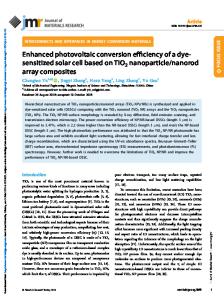Characteristics of diluted magnetic semiconductor based on Mn-doped TiO 2 nanorod array films
- PDF / 2,292,572 Bytes
- 9 Pages / 595.276 x 790.866 pts Page_size
- 93 Downloads / 328 Views
ORIGINAL PAPER
Characteristics of diluted magnetic semiconductor based on Mn-doped TiO2 nanorod array films Selma M. H. Al-Jawad 1 & Mukhlis M. Ismail 1
&
Sara F. Ghazi 1
Received: 5 May 2020 / Revised: 18 August 2020 / Accepted: 7 September 2020 # Springer-Verlag GmbH Germany, part of Springer Nature 2020
Abstract In this work, un-doped and Mn-doped TiO2 nanorod (NR) array films were successfully prepared by hydrothermal method that deposited on FTO substrate at different molar ratios (x = 0, 0.025, 0.05, 0.075, and 0.1). The prepared samples were examined by X-ray diffraction (XRD) and field emission scanning electron microscopy (FESEM). XRD illustrates the pure rutile phase in all samples. The preferred orientation along [001] for pure sample convert to [101] direction with increasing doping content. Lattice constants increase with increasing doping content. The top view of FESEM images show the uniformly distributed nanorod arrays. The nanorods’ length decrease, and their diameters increase with increasing doping content. The nanorods start to bevel from its vertical direction after doping. The crystal size of TiO2 NRs with different manganese doping has calculated using the Williamson-Hall plot. The saturation magnetism appeared in pure titanium oxide has been attributed to the oxygen vacancies, while it changed to diluted magnetic semiconductor after doped with Mn. Keywords Hydrothermal . Titanium oxide . Nanorod arrays
Introduction Titanium dioxide (TiO2) exists as three crystalline phases in nature, anatase, rutile, and brookite. These phases vary in their crystal structure and electronic behavior. The most common one is the rutile phase [1]. The control of the orientation is an important tool to adjust the preparation of nanocrystalline films [2]. TiO2 nanomaterials have remarkably attracted attention in many fields [3] such as photocatalytic degradation [4], photovoltaic cells [5], and electrochromic devices [6]. Also, TiO2 nanomaterial exists in different morphologies including nanorod array, nanotube arrays, and nanoparticles [7–9]. TiO2 nanorods have a small number of grain boundaries and can act as a single crystal, which provides fast electron transport [10]. TiO2 can be converted to magnetic semiconductor by doping with magnetic materials. The diluted magnetic semiconductor is formed by doping semiconductors with a magnetic element from transition metal ions such as (V, Cr, Fe, * Mukhlis M. Ismail [email protected] 1
Department of Applied Sciences, University of Technology, Baghdad, Iraq
Zn, Co, Ni, and Mn) which deliver extra magnetic momentum of the electrons [11]. The interaction between magnetic atoms for dopant with the host matrix induced ferromagnetism [12]. The TiO2 nanorods showed a higher photocatalytic activity than nanoparticle counterparts according to the previously studied [13]. Various synthetic strategies have been designed for the preparation of TiO2 nanorods, which include sol-gel template method [14], chemical vapor deposition (CVD) [15], and hydrothermal method [7].
Data Loading...






